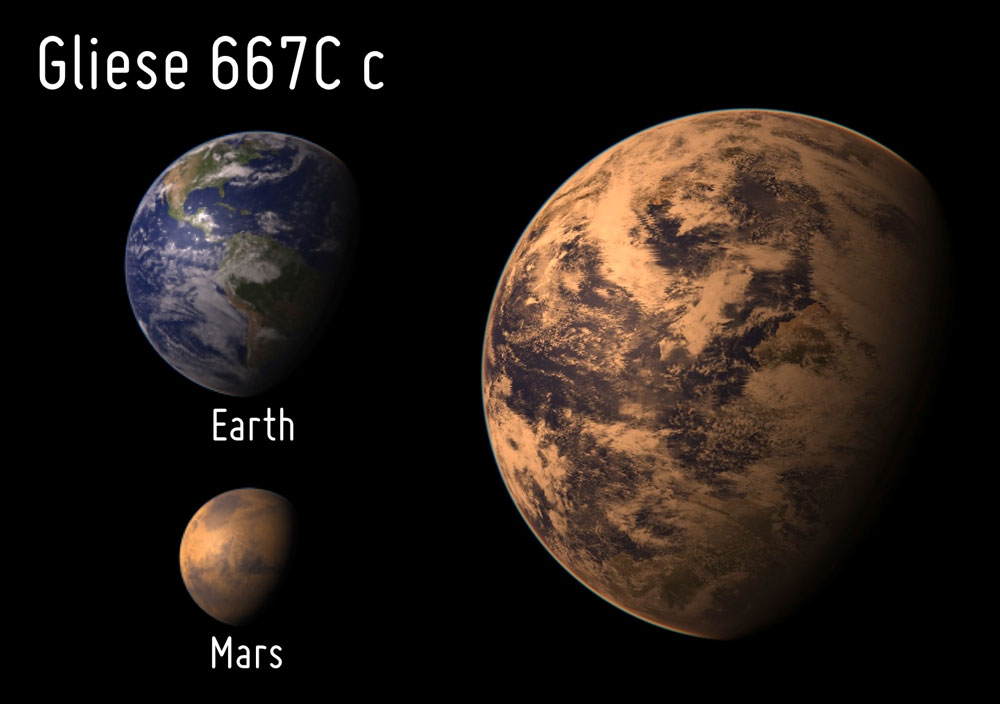Discover planet like earth
An international group of astronomers has just confirmed the existence of an exoplanet that can meet the perfect conditions for life to exist.
>>>11 new planetary systems discovered from Kepler glasses
The discovery of the planet in a livable area adds to the hope that astronomers will soon be able to answer the question of whether people are alone in the universe.
Guillem Anglada-Escudé at Göttingen University (Germany) is one of the astronomers who confirmed the existence of the new planet. The planet named Gliese 667Cc is orbiting a red dwarf, 22 light-years away from the earth. Red dwarfs are very popular in the vicinity of the sun. Usually red dwarfs come with giant gas bodies that the original structure is not stone.
Anglada-Escudé and colleagues analyzed the data from the Southern European Observatory, and found that Gliese 667 Cc is about 4.5 times larger than the planet. Astronomers now believe that the number of planets can live in the universe more than they previously thought.

Planet Gliese 667Cc
Scientists calculated that Gliese 667Cc received light from the red dwarf less than 10% compared to the light from the sun shining on our earth. However, most of the light is in the infrared region. Thus, the planet receives an equivalent amount of earth energy, meaning that the water on it can be liquid and the surface temperature is said to be equivalent to the temperature on earth.
Steven Vogt, an astronomer at the University of California, was also involved in the discovery of Gliese 667Cc, saying that the most important thing in finding an extrasolar planet is to find planets orbiting a star with about reasonably, not too close to evaporate the water and not too far away to freeze. Gliese 667Cc meets those standards.
About 20 years ago, scientists still argued about the existence of our exoplanets. But the process of finding these planets made great strides in 1995, when Michel Mayor and Didier Queloz published the first planetary discovery outside the solar system orbiting a sun-named star. is 51 Pegasi b. This discovery became a turning point in astronomy research. Since then, astronomers have confirmed the existence of more than 760 planets outside our solar system, but only four of those planets can have life.
One of the tools that helps astronomers hunt for the most effective solar system out there is the HARPS telescope. Scientists use this telescope to analyze the star's movements caused by the gravitational force between a star and the planet, thereby determining the latitude and size of a planet indirectly. Currently, they can detect planets that are 3-5 times larger than the Earth. In the future, HARPS telescope acumen will increase, helping astronomers find planets smaller than twice the size of the earth.
- Discover an earth-like planet that can have life
- Discover more planets 'brothers of the Earth' and can survive life
- The most Earth-like planet shows up
- Revealing the time when humans began to destroy the Earth
- Discover a new planet like the strange Earth
- Discover planet full of water
- Your planet is closest to Earth
- Discover new planet 21 light-years away from Earth
- Discover the first two large planets equal to the earth outside the solar system
- What new planet is '2nd Earth'?
- Information about 'Second Earth'
- Discover the mystery of 'Second Earth'
 Van Allen's belt and evidence that the Apollo 11 mission to the Moon was myth
Van Allen's belt and evidence that the Apollo 11 mission to the Moon was myth The levels of civilization in the universe (Kardashev scale)
The levels of civilization in the universe (Kardashev scale) Today Mars, the sun and the Earth are aligned
Today Mars, the sun and the Earth are aligned The Amazon owner announced a secret plan to build a space base for thousands of people
The Amazon owner announced a secret plan to build a space base for thousands of people